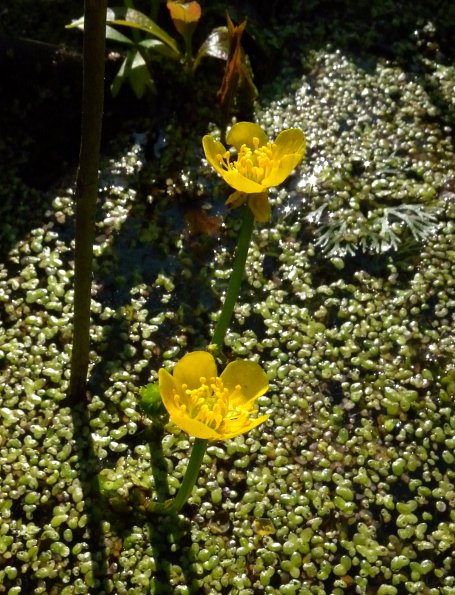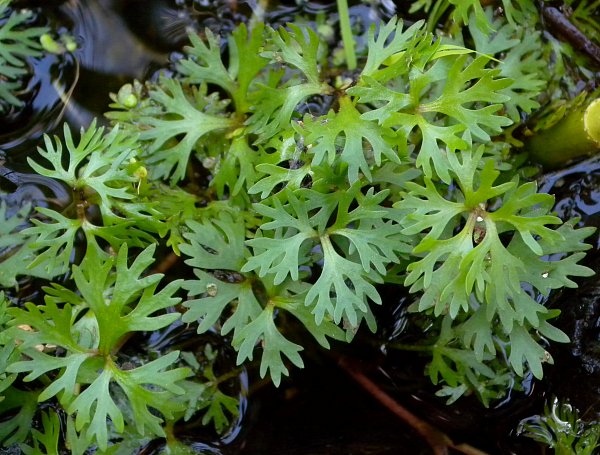
The narrow inflorescence is 3-12" long, consisting of either a long-stalked solitary flower or a branching stalk with 2-12 flowers; the flowers of an inflorescence are held above the water. Both the central stalk and pedicels of the flowers are light green, glabrous, terete, and relatively stout (although hollow within). Each flower is about ¾" across, consisting of 5-6 yellow petals (rarely more), 5 light green to pale yellow sepals, a ring of numerous yellow to golden yellow stamens, and a central head of pistils that is light green to yellow. The petals are oval or obovate in shape with rounded tips. The sepals are broadly elliptic or ovate in shape and either widely spreading to somewhat declined; they are about one-half as long as the petals. The blooming period occurs from late spring to mid-summer, lasting about 1-2 months. Afterwards, the flowers are replaced by small heads of beaked achenes. Individual mature achenes are about 2 mm. long and ovoid-flattened in shape; the beaks near their apices are about 1.5 mm. long. These achenes have the capacity to be carried by water currents, or they can be blown about by the wind on the surface of water. The root system is shallow and fibrous. Sometimes rootlets develop from the lower nodes of stems when they establish contact with wet ground. Colonies of plants often occur.

Cultivation: The preference is full or partial sun, shallow quiet water (up to 2' deep) to wet ground, and soil containing either mud or sandy mud. The location should not be subjected to strong water currents, high wind, or large waves.
Range & Habitat: The native Yellow Water Buttercup is occasional in most areas of central and northern Illinois, while it is uncommon in the southern section of the state (see Distribution Map). This plant is widely distributed in the NE, Midwest, Pacific NW, and other areas of the United States. It also occurs in parts of southern Canada. Habitats include shallow water and shores of ponds, shallow creeks or streams with slow-moving water, swamps, seep bottoms, and deep ditches. This plant is usually found in high quality wetland habitats.

Faunal Associations: The flowers are cross-pollinated primarily by bees, flies, and beetles (especially Prasocuris spp.). Both nectar and pollen are available as floral rewards to such visitors. The beetles may also gnaw destructively on the flowers and exposed leaves. Even though the foliage is somewhat toxic, some vertebrate animals use water buttercups as a minor source of food. The foliage and/or seedheads are eaten by the Trumpeter Swan, Muskrat, Wood Duck, Snapping Turtle, and Blanding's Turtle (Martin et al., 1951/1961; Bellrose, 1942/1976; Lagler, 1943). The finely divided aquatic leaves and low terrestrial leaves provide cover for insects and other small invertebrates.
Photographic Location: A sandy swamp at Indiana Dunes State Park in NW Indiana, and the bottom of a seep at Horseshoe Bottoms in Vermilion County, Illinois.

Comments: The flowers of Yellow Water Buttercup (Ranunculus flabellaris) are brightly colored and showy, especially when they bloom together in large plant colonies. This plant is remarkable in its ability to adapt to different wetland habitats by changing the morphology of its leaves. As a result, a leaves of a fully aquatic plant and the leaves of a terrestrial plant have little in common in terms of their appearance, except that they are both palmately divided into lobes. Nonetheless, their flowers and achenes are the same. The transformation of the leaves is strongly influenced by exposure to water and also by temperature. The only other semi-aquatic buttercup with yellow flowers in Illinois is Ranunculus gmelinii, or Small Yellow Water Buttercup. This latter species occurs in Cook and Menard counties, where it is rare. Small Yellow Water Buttercup is smaller in size overall; it has smaller flowers (about ½" across), inflorescences with fewer flowers (typically 1-4), less divided leaves, and achenes with shorter beaks. For example, the lower terrestrial leaves of this species are shallowly to moderately divided into lobes; they are ultimately divided into secondary lobes. In contrast, the lower terrestrial leaves of Yellow Water Buttercup are moderately to deeply divided into lobes; they are ultimately divided into tertiary lobes.